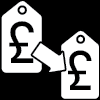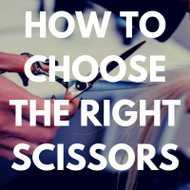How to Choose the Right Scissors
7th Feb 2022
Comfort
RSI and carpal tunnel syndrome are career killers, so look for scissors that minimise strain and feel "right" in your hand.
Handle design makes a huge difference! You can choose from level handles, offset or crane.
Level or even handles look symmetrical and straight like the Jaguar Pre Style Ergo. Offset handles with one handle longer than the other promote a more open hand position and lower the elbow when cutting like the TRI Samurai. Crane handles are similar to offset but the top handle is straight like the Kobe Zenith, which also helps lower the elbow while cutting. Additionally you can explore more unconventional ergonomic designs such as the flex with an adjustable thumb ring like the Jaguar Convex Flex.
Purpose
It's never "one-size fits all" with scissors, so consider the diversity of demand and get the right tool for the job.
Most of your work should be done with a scissor that's balanced in your hand and typically here's how to check-the ideal size will fit when you place the scissors on the palm of your hand with the finger hole touching the base of your thumb and the tip of the blade resting on the last section of your middle finger.
Thinning scissors like the Ama Contour remove weight fast and are an essential part of every kit while texturizing scissors such as the Kobe K14 removes less weight but add texture and help to personalise and style a shape.
Quality and Price
These two go hand-in-hand: much of the quality (and the price) in any scissor is in the materials and the manufacturing.
Cheaper blades tend to be mixed metal and with a bevelled edge. The blend of materials makes them a lightweight choice and the micro serrations on the cutting edge of most bevelled blades stop the hair from slipping during cutting like the Jaguar Pre Style Ergo. Choose a polished edge for slicing.
For a more premium option, convex blades are hollow ground and very sharp, delivering a razor-like cutting edge. These solid stainless steel scissors are often referred to as "Japanese Style" and are great for slicing and precision work. Some good examples can be found in the Passion Scissors and Kasho Scissors ranges.
PS If you're left handed PLEASE don't feel under pressure to cut with right-handed scissors. All good suppliers should offer a great choice of left-handed scissors!
PPS CoolBlades offers free, no-obligation advice on choosing scissors, so just call 01253 893091. We're here to help.





